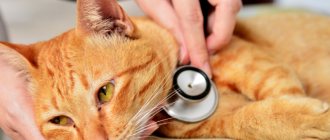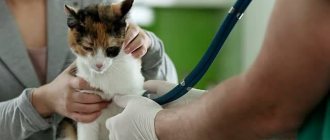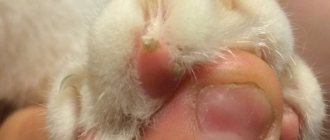Pulmonary edema in a cat or acute pulmonary failure is not an independent disease, but a complication of certain ailments of a cardiogenic or non-cardiogenic nature. It is accompanied by acute suffocation, progressing as the swelling increases. If veterinary care is late, the animal dies from asphyxia. In the article we will look at the causes of pulmonary failure in animals, answer the questions: why the disease is fatal, whether the pathology can be cured, what preventive measures exist.
What it is
The process of breathing in animals, as in humans, occurs with the participation of alveoli - peculiar bubble formations in the lungs, intertwined with a network of blood vessels. Under normal conditions, the alveoli of the lungs during inhalation are filled with oxygen entering the blood, which then carries it to the brain, nourishes the heart and tissues. When you exhale, exhaust air containing carbon dioxide is released through the alveoli.
In pulmonary insufficiency (edema), for various reasons, transudate (edematous fluid) and the liquid part of the blood enter the alveoli - infiltration. A sharp decrease in the working volume of the lungs disrupts the breathing process and leads to progressive oxygen starvation of the body.
What is pulmonary edema
Pulmonary edema in a cat is not an independent disease. This life-threatening pathology is a complication of other diseases - an abnormal accumulation of fluid occurs in the cat’s lungs.
What happens with pulmonary edema
Extravascular water accumulates in the pulmonary alveoli, reaching a critical volume. Normally, the alveoli (vesicles) of the lungs are responsible for breathing and supplying oxygen to the bloodstream. The lungs, filled with fluid coming from diseased blood vessels and tissues, cannot cope with their function. The cat cannot breathe normally, suffocates, and experiences oxygen starvation.
This condition develops due to:
- increasing permeability between alveoli and capillaries;
- increased pressure in the capillaries of the lungs;
- violations of the drainage function of the lymphatic system of the lungs.
Stages of pulmonary edema
Depending on which cavities the fluid has entered, edema is divided into two stages:
- Interstitial - fluid entering the connective tissue of the lungs (interstitium).
- Alveolar – fluid in a cat’s lungs fills the alveoli.
Pulmonary edema in a cat can develop rapidly (acute) or gradually (chronic).
Causes of the disease
Pulmonary failure in cats almost always develops as a complication of heart disease, but it can also have a different, non-cardiogenic nature.
Cardiogenic pulmonary edema
The most common cause of pulmonary edema is progression of heart failure in cats. Heart failure develops due to disruption of the left ventricle of the heart. This provokes pathology of the pulmonary circulation and swelling in various organs and tissues, including the lungs. Cardiogenic edema accompanies the following diseases:
- cardiomyopathy;
- aortic insufficiency;
- mitral stenosis of the heart;
- pulmonary embolism;
- myocarditis;
- hypertension;
- infective endocarditis.
Cardiogenic pulmonary edema in cats is characterized by a gradual filling of the alveoli with fluid, an increase in oxygen starvation of tissues, turning into asphyxia. In this case, in order to save the animal, resuscitation measures cannot be avoided.
Non-cardiogenic edema
Infectious and non-infectious ailments that may be complicated by pulmonary insufficiency are:
- diseases of the respiratory system: pneumonia, bronchial asthma, tuberculosis, chest injuries, inhalation of volatile toxic substances;
- diseases of the excretory system: nephritis, renal failure;
- Gastrointestinal diseases: pancreatitis, intestinal obstruction, volvulus;
- diseases of the nervous system: encephalitis, meningitis, brain tumors, reaction to anesthesia after sterilization or castration;
- complications of infectious diseases: influenza, inflammation of the upper respiratory tract, plague;
- severe allergic reactions.
Predisposition to disease
Pulmonary edema of a cardiogenic nature more often occurs in cats of certain breeds that have a hereditary tendency to cardiovascular pathologies. This breed defect is inherent in many artificially bred cat breeds:
- sphinxes;
- Maine Coon;
- the British;
- Scottish Fold;
- Persian and representatives of other breeds.
Kittens more often suffer from traumatic pulmonary edema. The pathology develops in them after chest injuries, to which they are very susceptible.
There is no difference in the incidence of this pathology between males and females.
Forecast
Pulmonary edema in cats is a very dangerous condition that develops rapidly and can be fatal.
Cat owners should be prepared for such developments and understand that in this case time is everything.
The sooner a cat is shown to specialists, the sooner it receives first aid, the higher its chances of survival.
In a hospital setting, there are all the necessary tools for diagnosing and assisting an animal: x-rays, an oxygen chamber, injections and medications.
Competent intensive therapy at the initial stage of the disease is a guarantee of success. It is unacceptable to treat pulmonary edema on your own - it can kill your beloved pet.
Types of disease
Based on the rate of progression of symptoms, several types of disease are distinguished:
- Lightning fast - has rapid development, leading to rapid death.
- Acute - characterized by a high rate of development. Symptoms increase over several hours. In this case, prompt treatment is the only way to save the animal.
- Subacute - has a wave-like development. Periods of increasing symptoms are followed by periods of subsiding.
- Protracted - has erased symptoms. Characteristic of chronic pathologies.
Treatment method and prognosis
There is no single treatment regimen for pulmonary edema; it will depend on the cause that caused the pathological process and, accordingly, is aimed at eliminating it.
If the condition is critical, the animal must be given first aid. To do this, the cat is given an intramuscular injection of a drug that relieves swelling and eliminates hypoxia - Prednisolone, Dexamethasone, Diprospan, Hydrocortisone.
Oxygen replenishment is carried out by placing the pet in a pressure chamber, using an oxygen mask, and performing pulmonary ventilation procedures.
To remove excess fluid, diuretics are used (injected or orally).
To eliminate the infectious diseases that caused the edema, a course of antibiotic therapy is prescribed. For viral etiology of edema, antiviral agents are indicated.
During illness, cats usually experience severe stress, so they are prescribed sedatives.
If, after carrying out the necessary medical procedures, the cat’s condition has stabilized and his health is no longer in danger, the fluffy cat is sent home to recover.
If all first aid measures and further treatment were carried out correctly, the prognosis is positive. However, if a sick pet is brought to the clinic too late, the risk of death is very high.
Symptoms of the disease
In cats, symptoms of pulmonary edema include signs of oxygen deprivation. Their onset may be preceded by a characteristic state of the animal, indicating a deterioration in health. This is anxiety, hoarse cough, refusal to eat, pallor of the mucous membranes.
With an increase in oxygen deficiency in the tissues, the animal begins to suffocate. The state of lack of air is determined by the specific behavior of the cat:
- heavy breathing with an open mouth and protruding tongue;
- a position in which it is easier to breathe: paws widely spaced, neck elongated and head lowered;
- cold paws;
- bluish mucous membranes of the lips and nose;
- abdominal breathing.
Symptoms
Lethargy, inactivity and lack of appetite in a cat are the first warning signs of pulmonary edema. These harmless signs are characteristic of many diseases, so owners do not immediately begin to sound the alarm. The owner needs to carefully monitor the pet’s behavior, mood and appetite. But the animal does not eat or move, because it has suddenly lost its breath and cannot breathe freely. The mouth opens slightly in an attempt to swallow more air, the tongue hangs lifelessly, and the gaze becomes lost and meaningless.
If suddenly these few signs did not help to detect the cat’s illness, then the following signs should definitely alert the owners. Suddenly wheezing or gurgling appears, the cat begins to breathe convulsively with an open mouth like a dog and walk restlessly. She may have a wet cough with bloody mucus or foam. The cat can lie on its belly with its paws spread wide, and then simply assume a side position. Body temperature may drop sharply, this can be determined by cold extremities. The cat's belly begins to shake, trembling occurs in the area of the withers, and the heartbeat quickens.
Not all symptoms may occur at the same time. Often one is replaced by another, which makes it difficult to make a prompt diagnosis. Symptoms may appear in waves or occur rapidly, bringing the cat closer to death. The cat must be urgently hospitalized.
First aid before going to the veterinary clinic
If there are signs of pulmonary edema, immediate assistance to the animal is very important, since it determines whether resuscitation will be successful. Before delivering the cat to the clinic, it is necessary to make the breathing process as easy as possible for her using improvised methods:
- give an injection of a diuretic (Furosemide);
- open the windows or take the cat out into the fresh air;
- provide the animal with complete rest and limit physical activity;
- do not disturb or take any forceful action towards him;
- deliver to the clinic as quickly as possible;
- During transportation, it is advisable to place the animal on its side.
If first aid is provided correctly, then subject to a professional approach to the choice of treatment method, there is hope that the animal will recover.
Pulmonary edema in cats. Symptoms of edema, treatment of pulmonary edema in cats.
Pulmonary edema in cats
is a disease that is characterized by blood overflow of the capillaries and pulmonary veins, resulting in the leakage of blood plasma into the lumen of the bronchioles, bronchi and interlobar connective tissue.
Blood stagnation occurs in the lungs and, as a result, swelling of the lungs and mucous membranes of the bronchi occurs. Pulmonary edema manifests itself as a consequence of insufficient cardiac activity.
The causes of pulmonary edema can be physical overload, inhalation of hot air, sunstroke and heatstroke, the action of highly irritating gases, lobar pneumonia, pasteurellosis, plague and other diseases.
If urgent measures are not taken, the animal may die.
Symptoms of pulmonary edema in cats.
Severe shortness of breath appears, the limbs become cold, breathing becomes bubbling and difficult, the skin and mucous membranes become bluish in color, and when coughing a large amount of sputum is released, very often mixed with blood.
If these symptoms appear, the cat should be given rest by placing it in a well-ventilated, but not cold, room, given caffeine, sulfocamphocaine, cordiamine, expectorants, and urgently call a veterinarian.
The diagnosis is made on the basis of thermometry, pronounced clinical symptoms and auscultation.
Treatment of pulmonary edema.
Expectorants, cardiac drugs (caffeine, adrenaline, cordiamine, etc.) and stimulants are used. A ten percent calcium chloride solution and a forty percent glucose solution are prescribed intravenously.
If signs of hypostatic pneumonia appear, sulfonamide drugs and antibiotics are used.
Pulmonary edema in cats: causes, symptoms and treatment
No matter how hardy our pets are, they cannot live without air. Pulmonary edema in cats is oxygen starvation: every cell of the body slowly dies, literally suffocating. Do not rely on your own strength; this is not the case when you can cope with an illness without the help of a doctor. If pulmonary edema is suspected, take your cat to the clinic immediately. This is a deadly condition that cannot always be overcome, even if you provide your pet with timely assistance.
The lungs consist of alveoli that resemble bunches of grapes. Each “berry” is filled with air and entangled in a network of blood vessels. When a cat takes a breath, the blood cells washing the alveoli are saturated with oxygen, releasing carbon dioxide, which leaves the alveoli at the moment of exhalation. The cause of pulmonary edema in a cat is the filling of the alveoli with fluids, which leads to a decrease in the functional volume of the alveoli and oxygen starvation: there is no air in the alveoli - the cells have nothing to “breathe” and there is no way to get rid of processed gas
There are a lot of factors that provoke pulmonary edema. And only a veterinarian can reliably determine the cause of a serious condition:
heart problems leading to stagnation of blood in the lungs and increased blood pressure;
injuries of various types, concussion, electric shock, fall from height, etc.;
anaphylactic shock, allergy;
poisoning with medications, toxins;
seizures, epilepsy;
kidney disease, liver disease, exhaustion, neoplasms.
The first symptoms of pulmonary edema in cats are a strange posture and decreased reactions to stimuli. The cat feels that she does not have enough air, stands up, leans on her widely spaced front paws and slightly stretches her head forward. Possible coughing, gagging, trembling of the muscles of the withers and back (“nervous” waves). The cat does not turn around when called or looks at the owner with a plaintive look, but does not approach - the pet looks distant, lost and frightened.
With pulmonary edema in cats, symptoms can increase rapidly, every minute, or appear gradually, coming in attacks:
the cat restlessly walks back and forth, then falls on its side, stretches out its paws and does not change its position;
breathing is frequent and shallow, the cat greedily swallows air, abdominal breathing;
wheezing and gurgling are heard in the chest, not necessarily on both sides. In some cases, there is belching with impurities of pinkish foam or mucus, coughing up liquid;
the mucous membranes are bluish or very pale, which is especially noticeable when examining the eyelids and lips. Sometimes the mucous membranes quickly turn red, and only then turn blue.
As mentioned above, at the first suspicion of pulmonary edema in cats, the pet must be taken to the clinic. They transport the cat in a position lying on its side, but do not force it down (if it wants to sit, let it sit). The box is covered with light-proof fabric to reduce the degree of excitement - in the current situation this is extremely important.
If, after radiography and examination, the diagnosis of pulmonary edema in cats is confirmed, treatment is started with a high dose of diuretics (for example, furosimide). Dexamethasone and analogs are suitable as an antiallergic and anti-inflammatory agent. Cocarboxylase normalizes heart function, sulfocamphocaine stimulates breathing. Oxygen therapy is indicated - the cat is placed in a special chamber or an oxygen mask is applied to its face. In severe cases, surgery is necessary. Pulmonary edema in cats requires complex treatment; the veterinarian must be experienced, attentive and act without relying on general schemes. It is highly advisable to leave the cat in the hospital, since without the supervision of a professional it is easy to miss the deterioration of the weakened body.
Related articles:
Diagnosis of the disease
Diagnostic procedures should be as prompt as possible, since suffocation can progress rapidly. Sometimes it is advisable to start treatment procedures in parallel with diagnostics, so as not to miss time. Basic diagnostic measures:
- A detailed survey of the owner about the behavior and well-being of the animal since the moment of illness.
- External examination and auscultation (listening) of the lungs and heart.
- X-ray examination of the chest. Based on the pulmonary pattern, one can determine the nature of the pathology, since areas of the lungs that do not take part in the breathing process and the level of fluid in the alveoli are visible. Pathological changes in the heart muscle are also determined. X-rays also help to carry out differential diagnosis, which makes it possible to separate the disease from other pathologies of the heart and respiratory system.
- Ultrasound of the heart is prescribed if a cardiogenic origin of the disease is suspected, to determine how much the contractility of the left ventricle is altered.
- An electrocardiogram provides information about the presence of ventricular hypertrophy, arrhythmias and ischemia of the heart muscle.
- A general and biochemical blood test will complement the picture of the disease with a number of clinical signs.
Diagnostics
Comprehensive diagnosis of the disease includes:
- Chest X-ray.
- Echocardiography - ultrasound of the heart.
- Listening with a stethoscope.
- Analysis of urine.
- General blood analysis.
- Blood test for biochemistry.
The test results are processed by a specialist to determine the root cause of the swelling.
Important!
The diagnosis of pulmonary edema cannot be made solely on the basis of anamnesis and examination of the pet - remember this when choosing a clinic and attending physician!
Treatment of the disease
Treatment of pulmonary edema begins with resuscitation measures designed to support the cat’s life. First of all, this is oxygen therapy, which consists of forcing the cat to breathe through a special mask where oxygen is supplied or placing it in an oxygen chamber for a certain time.
If the cause of pulmonary insufficiency is a foreign body or vomit entering the respiratory tract (aspiration), then they are removed by tracheostomy (extending the trachea).
The main treatment consists of drug therapy:
- getting rid of swelling and excess fluid in tissues - diuretics, diuretics (Furosemide);
- normalization of heart function - drugs that relieve heart failure and affect tissue metabolism (Carboxylase);
- decreased pressure in the pulmonary circulation - ganglion blockers (Bromide, Trimetaphan);
- stimulation of breathing - drugs that stimulate the parts of the brain responsible for breathing (Sulfocamphocaine);
- relieving inflammation - antihistamines (Dexamethasone);
- If pulmonary edema occurs in a cat due to a bacterial infection, then treatment with antibiotics is started.
After the acute condition has been relieved, therapy for the underlying disease begins, during which medications of various types are used, according to indications, depending on the nature of the disease.
Treatment of pulmonary edema and associated diseases should only take place in a hospital, since the serious condition of the animal requires constant medical supervision.
Treatment
In the event of a sudden development of symptoms of pulmonary edema, many may try to relieve them on their own. To do this, he needs to administer Furosemide or Lasix, which have a diuretic effect (dosage 0.1 ml per 1 kg).
Before administering the drug, be sure to consult a veterinarian. For kidney disease, use diuretics with caution. It is advisable to film a cat’s attack on your phone camera and send the video to the doctor for a clearer understanding of the picture.
If there is fear and doubt, then it is better to refrain from independent actions. Do not delude yourself that one injection is enough for recovery. The cat must be taken to a veterinary clinic immediately. The main thing is that the cat owner should not panic. Fear and panic can be transmitted to the cat and worsen its condition. We must try to isolate the animal from external noise influences and transport it in a lateral position. If he starts to be stubborn and tries to sit down or stand up, don’t put pressure on him. The animal itself will choose a comfortable position in the carrier.
To relieve acute symptoms, the veterinarian supplies the cat with oxygen through a mask or performs artificial ventilation. Then a general and biochemical blood test is performed, urine is collected, and an x-ray is taken to identify the causes of pulmonary edema in the cat. To identify a cardiogenic or non-cardiogenic factor in the origin of pulmonary edema, an ECG and ultrasound of the heart are prescribed.
Once the diagnosis is confirmed, the cat is given potent diuretics to remove fluid and sedatives are prescribed to restore the nervous system. In the most severe cases, a tracheotomy or thoracentesis has to be done. After all the procedures, the cat is placed in a hospital, preferably a separate one, under the 24-hour supervision of doctors. For quick recovery, droppers with vitamin complexes are prescribed.
When returning home, the cat must be given additional care during the rehabilitation period. It is necessary to follow all recommendations of the veterinarian. Cats with cardiogenic factor require a lifelong course of medication.
It happens that a cat cannot be saved if a relapse occurs. Owners must be prepared for this.
You cannot perform artificial respiration on your own and try to pump out the fluid. You may lose time and not have time to save the animal. Sometimes the minutes count.
Disease prevention
There are no special preventive measures to protect against the disease. Prevention consists of careful monitoring of animals that are at risk for cardiovascular and colds. These are predisposed breeds (Maine Coons, Sphynxes, Persians, Scottish, British), weakened, with low immunity, overweight, animals that move little.
If the disease is cured in time, then we can say with a high degree of confidence that complications will not develop.
The main preventive measures are:
- protect the cat from physical overload;
- protect from unfavorable environmental conditions (avoid overheating and hypothermia, being in drafts);
- monitor the safety of cats and kittens at home (protect access to wires and electrical appliances, ensure that the animal cannot inhale fumes of aggressive chemicals, protect from falls and injuries);
- strengthen the immune system, do not skip scheduled vaccinations;
- undergo regular preventive examinations with a veterinarian.
The disease often has a poor prognosis. But the attention and love of the owner can work a miracle. Competent and timely veterinary care (especially in non-cardiogenic disease) makes the chances of recovery quite high.
Complications and prognosis
Pulmonary failure in cats is characterized by a rapid progression. Symptoms appear within one day. According to the Moscow Veterinary Academy, signs can develop within 2-3 hours. The cat tries to breathe in air, but she can’t. Without timely intervention, this can lead to death due to the development of oxygen starvation, which is accompanied by such deteriorations: impaired blood circulation in the brain, cardiosclerosis, ischemia.
With such a pathology, the animal must be urgently shown to a specialist to provide emergency care.
It is also highly undesirable to rehabilitate a cat at home, since only specific medications can relieve swelling. You need to understand that the pathology will not go away on its own, and the sooner the animal owners see a doctor, the greater the chances of recovery. The prognosis is not always favorable. Since the development of the disease does not last very long, most veterinarians say that edema is a dying condition of the animal.
Prevention
Preventing the development of the disease involves monitoring the health of the animal. This especially applies to cats with weakened immune systems and breeds that are more susceptible to edema. It is these sick animals that should be checked by doctors every six months. The animal must be kept in comfortable conditions with a favorable temperature. Excessive physical activity should not be allowed. It is also important to give your cat the necessary vitamins and vaccinations. It is important to treat the original source of the disorder so as not to provoke a relapse.
Causes
Pulmonary edema in cats develops as a result of various causes. But it is worth remembering that this pathology is not a disease. Pulmonary edema is a serious symptom and type of complication that occurs against the background of an underlying illness.
Pulmonary edema in cats is divided into two main types:
- cardiogenic pulmonary edema in cats;
- swelling not associated with diseases of the cardiovascular system.
Cardiogenic
Very often, the cause of pulmonary edema in cats lies in heart disease. Some destructive processes in the heart and blood vessels lead to a deterioration in the flow of blood and lymph, as a result of which fluids stagnate and begin to fill the lungs.
Lung tissue itself is very porous, and it is full of cells, which is why this organ suffers in the first place. Cardiogenic pulmonary edema in cats is characterized by a gradual filling of the alveoli with fluid, an increase in oxygen starvation of tissues, turning into asphyxia. In this case, in order to save the animal, resuscitation measures cannot be avoided.
Cardiogenic pulmonary edema in a cat occurs when:
- Hypertrophic cardiomyopathy.
- Chronic heart valve diseases.
- Heart defect.
- Heart failure.
- Arterial hypertension.
- Cardiosclerosis.
- Pulmonary embolism.
Heart disease can be congenital or acquired. Cats of artificially bred breeds suffer from similar ailments more often.
Non-cardiogenic
The cause of pulmonary edema can also lie in injuries, disorders in the body, infectious diseases, and others:
- Allergic reactions (including to anesthesia).
- Aspiration pneumonia.
- Injuries to internal organs as a result of falls from height.
- Electric shock.
- Choking (carbon smoke poisoning).
- Anemia.
- Heatstroke.
- Lung cancer.
- Laryngeal paralysis.
- Head injuries: bruise and concussion.
- Severe stress.
- Injuries to internal organs during sterilization/castration operations.
- Poisoning with poisons and chemicals.
- Bacterial blood infections.
- Pancreatitis.
- Prolonged seizures (epilepsy).
- Poisonous snake bites.
- Uremia is intoxication resulting from renal failure.
- Anorexia.
- Sepsis.
- Aspiration is the entry of vomit into the respiratory tract.
Many owners who love to overfeed their pets are unaware that obesity leads to heart disease. This, in turn, entails other problems, including swelling of the organs.











